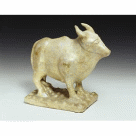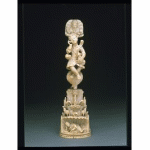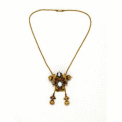The art objects belonging to the Islamic world and to the period of the Mughal Empire’s growth are exhibited in the Jameel Gallery and the South Asia Gallery of the Victoria and Albert Museum in London. If the objects presented in the Jameel Gallery reflect the standard features of the Islamic art, the objects typical for the Mughal art can be discussed as influenced by the combination of the Islamic and European tendencies. From this point, the development of the Mughal art depends on the historical progress of the South Asian region during the 16th-19th centuries. To examine the specific elements of the Islamic and Mughal arts in detail, it is necessary to discuss the features of the definite objects observed in the Jameel Gallery and the South Asia Gallery.
The Specific Features of the Islamic Art
The Islamic art is characterised by the unique variety of used patterns, styles, motifs, colours, and materials which can be associated with the rich Islamic art. For instance, it is important to note that both naturalism and abstraction are characteristic for the Islamic art of the 12th-13th centuries (Brend, 1991, p. 28). In the Jameel Gallery, it is possible to observe the exhibited naturalistic figure of a bull made in the 1200s and the abstracted filter resembling an elephant made in the 1000-1200s. In spite of the observed differences in style, these objects represent the characteristic elements of the Islamic art. The ceramic fritware figure of a bull is made to depict the animal’s features in detail and naturalistically, reflecting such small elements as the curled tail (Figure 1; Room 42: Islamic art, 2013).

The function of the figure of a bull cannot be stated clearly, but the function of the abstracted filter made of earthenware is obvious. Many objects representing the Islamic art have not only the cultural or art value but also the practical significance, providing the glimpses into the Islamic households and modes of life. The earthenware filter for a water-jar made in the 1000-1200s and observed in the Jameel Gallery is decorated with the abstract patterns to present the image of an elephant (Figure 2; Room 42: Islamic art, 2013).

Moreover, a lot of great artifacts representing the Islamic art are made of metal. During many centuries, craftsmen developed the metalwork and jewellery production as the main type of the Islamic art because of the focus on creating new forms and on decorating the metal objects with jewels and glaze (Canby, 2005, p. 31-34). To examine the features of the Islamic metalwork, it is necessary to concentrate on the tray made of brass during the 14th century. This circular tray as the example of the Islamic metalwork was originally decorated with gold and silver. Thus, the engraved areas in the tray could be decorated with gold or silver in order to represent the luxurious character of the tray. It was traditionally for the Islamic craftsmen to decorate metal objects with gold and silver to provide the necessary accents (Figure 3; Room 42: Islamic art, 2013).

The other specific feature of the Islamic art is the use of calligraphy in order to decorate different types of objects which can be made of ceramics, paper, wood, and other materials. That is why, the patterns of calligraphy are observed on various objects and materials typical for different historical periods (Ruggles, 2011, p. 53). Thus, the example of the Islamic calligraphy can be observed on the fragment of the fritware tiles and decorations made during the 13th century as the symbol of the Islamic people’s wisdom and awareness. In spite of the fact that it is possible to observe the elements of the Chinese influence on the provided tiles, the calligraphic pattern remains to be the distinguishing feature of the Islamic art (Figure 4; Room 42: Islamic art, 2013).

The discussed objects are the good examples to represent the Islamic art and culture because they reflect the characteristic features of the Islamic art which are the focus on the metalwork, decoration with the help of gold, silver, and glaze, the discussion of calligraphy as the independent art, and the use of naturalistic and abstract tendencies to create the art objects.
The Characteristic Elements of the Mughal Art
The Mughal art is the unique combination of the elements reflecting the Indian and Islamic styles and art tendencies typical for the Persian art. The Mughal art is characteristic for the period of the Mughal Empire’s development (the 16th-19th centuries), and the objects typical for this art are traditionally come from the Indian subcontinent. The distinctive features of the Mughal art are represented in the focus on the great naturalism and realism. During the 18th-19th centuries, the Mughal art was influenced by the Colonial culture and art and by the specific features of the European arts (Guy, Crill, & Swallow, 1990, p. 58-60). Thus, the Mughal art characteristic for this period is the unique combination of the Asian, Islamic, and European motifs and elements.
The perfect example to demonstrate the latest period of the Mughal art is the painting or the work on paper. The painting observed in the South Asia Gallery is Akbarnama made during the 16th century. The elements of the Mughal art are reflected in the tradition to depict the everyday scenarios and in use of specific water colours and decorations with the help of gold on paper. The discussed painting is the illustration of the historic event, representing the emperor Akbar (Figure 5; Room 41: South Asia, 2013).

The Mughal Empire’s development as the progress of any other large empire can be characterised by the mix of cultures, arts, religions, and beliefs. That is why, the Mughal art also represents the changes and combinations in the religious visions of the nations living in the empire (Waghmar, 2004, p. 110). The figure of the Good Shepherd is one of the most important religious symbols characteristic for the period of the Mughal Empire’s growth. The ivory figure of the Good Shepherd made in the 17th century is the representation of the spiritual visions of the empire’s population. This figure group represents the spiritual ideals typical for the Indo-Portuguese population in the form of the carved figures of Christ, God the Father, and the Holy Spirit (Figure 6; Room 41: South Asia, 2013).

The 18th century influenced the development of the Mughal art through the spread of Colonial tendencies. That is why, it is possible to determine the objects obtained as a result of Colonialism. The cotton dress made in Coromandel Coast is the perfect example to show the impact of the Colonialism tendencies on the South Asian culture during the 18th century. Such open dresses made of cotton and decorated with gold elements were not typical for the Asian countries, but they were actively worn in the Netherlands (Figure 7; Room 41: South Asia, 2013).

During the next 19th century, the European art influences the art of the South Asia more intensively. Thus, the craftsmen and the jewellery masters of India become to reflect the European patterns in necklaces and other elements of jewellery. In the South Asia Gallery, it is possible to observe the gold necklace made in the 19th century. This necklace is decorated with rubies and diamonds and formed according to the European tradition, particularly, according to the British tradition. However, the specific metalwork of the Indian masters is also observed in relation to this object (Figure 8; Room 41: South Asia, 2013).

The exhibitions in the Jameel Gallery and the South Asia Gallery of the Victoria and Albert Museum in London present the great variety of art objects typical for the Islamic art and for the Mughal art. These artifacts are important to be examined in order to conclude about the specific features of the Islamic art and Mughal art.
References
Brend, B. (1991). Islamic art. USA: Harvard University Press. Web.
Canby, S. (2005). Islamic art in detail. USA: Harvard University Press. Web.
Guy, J., Crill, R., & Swallow, D. (1990). Arts of India, 1550-1900. London: Victoria & Albert Museum. Web.
Room 41: South Asia. (2013). Web.
Room 42: Islamic art. (2013). Web.
Ruggles, F. (2011). Islamic art and visual culture: An anthology of sources. USA: John Wiley & Sons. Web.
Waghmar, B. (2004). The Empire of the Great Mughals: History, art and culture. USA: Reaktion Books. Web.